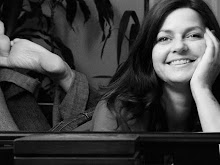Each image takes about 20 minutes to a half hour to create... and that's counted after the dark room has been set up ahead of time, the chemical batches concocted and all the glass plates prepared (each plate taking about 15 minutes).
When the portrait subject arrives, Fred chats a bit about the upcoming process and then I apply make-up, or just touch-ups, "analog retouching" as it were. When the image is actually made, it is a physical object - as is - and you can't touch it up afterwards, so any concealer or adjustments need to be made ahead of the capture. Also, the process tends to darken reds, so blemishes, rosy noses, etc. not only show up, but are sometimes darker than in real life. And really, it's not fair that a passing pimple remain on your image for 150 years, is it? Therefore, even the boys get a light concealer application. :)
Each custom setting is generally organized and propped ahead of time, as is the lighting set-up, so Fred starts working with the subject to settle on a pose, roughs in his focus, and leaves to sensitize the first plate. I stay to chat and do final touch-ups. When Fred returns, the pose is recreated, final focus made, then... stay still! For anywhere from about 10 seconds to 2 minutes, depending on too many factors for me to know or list. Fred and I both also stay still so as not to distract the subject: it's imperative for a sharp image that they not move.
Once the time is up, Fred removes the camera back with the undeveloped plate and returns to the dark room, while the subject and I relax and wait. I usually make tea or coffee, and have some lovely chats in the spaces between image captures. But everything else is secondary to the moment when Fred appears with the (literally) dripping wet developed plate and we gather around to look. In its native form, the glass is clear and the image more like a negative, but viewed with a black cloth behind it, the image pops out as a positive, and that first view is like magic.
Sometimes a technical glitch will require shooting a second plate, occasionally an adjustment to lighting or pose, but for the most part this whole process is geared toward one capture, one final, lasting unique portrait.
I think I may be obsessed, too.









No comments:
Post a Comment